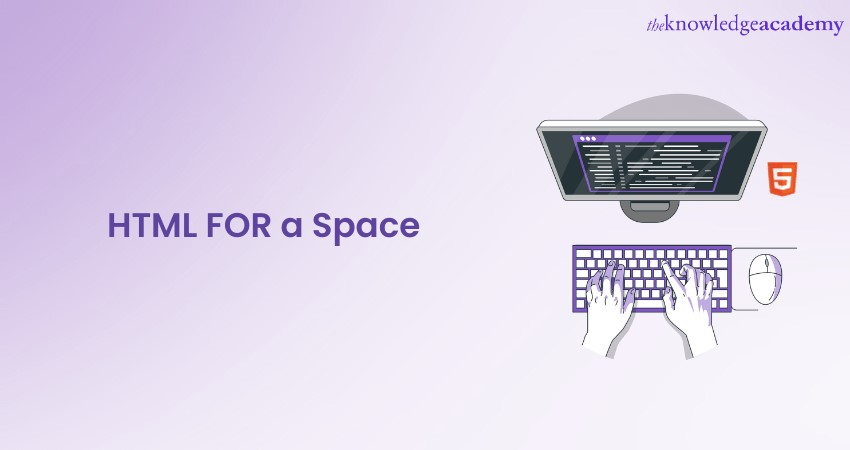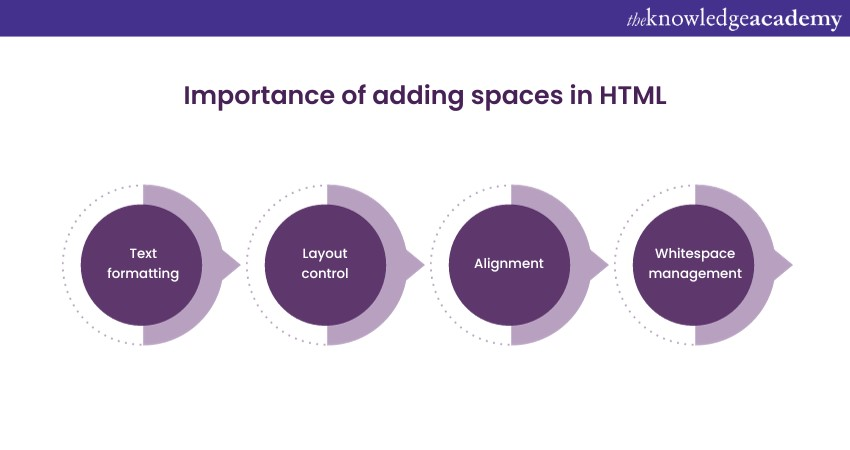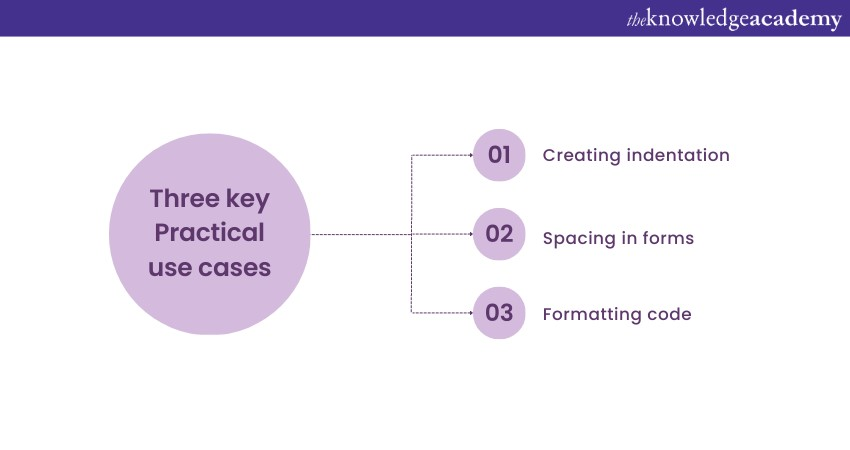We may not have the course you’re looking for. If you enquire or give us a call on +971 8000311193 and speak to our training experts, we may still be able to help with your training requirements.
Training Outcomes Within Your Budget!
We ensure quality, budget-alignment, and timely delivery by our expert instructors.

Do you want to learn how to add spaces in HTML? It's a handy skill for Web Design. HTML, the web language, provides simple methods for creating gaps between words and elements on your web pages.
Statista said around 53 per cent of people used HTML/CSS, Python, SQL, and TypeScript in 2022. It takes time to learn HTML and other programming language. In this blog, Learn HTML for a Spacelike white spaces, including spaces, tabs, and line breaks, which are generally collapsed into a single space character.
Table of Contents
1) Why add Spaces in HTML?
2) HTML Space elements
a) Non-Breaking Space ( )
b) En Space ( ) and Em Space ( )
c) Line Breaks (<br>)
3) Adding Space in CSS
a) Margin
b) Padding
4) Spacing in HTML Entities
5) Practical Use Cases
a) Creating Indentation
b) Spacing in Forms
c) Formatting Code
6) Conclusion
Why add Spaces in HTML?

Adding HTML Space elements is important for several reasons:
a) Text formatting: HTML Space elements, like the non-breaking space ( ), allow you to control how text appears on your web page. They ensure that specific words or characters remain together and do not break onto a new line, preserving the formatting and readability of your content.
b) Layout control: Proper spacing is crucial for structuring your web content. HTML Space elements help you organise text, paragraphs, and details on your page, making it more aesthetically pleasing and easier to navigate for your visitors.
c) Alignment: HTML Space elements help you align text and features correctly. Whether it's aligning text within a paragraph or positioning elements on a web page, having control over spacing ensures that your design looks clean and professional.
d) Whitespace management: Without HTML Space elements, your content might unintentionally have excessive or inconsistent spacing. Using these elements, you can precisely manage whitespace, preventing spacing issues that disrupt your layout.
HTML Space elements
HTML Space elements, like , and , help control spaces in web content. They prevent text from breaking, fine-tune spacing, and enhance layout, ensuring neat and organised web pages.
Non-Breaking Space ( )
The non-breaking space, represented by , is a fundamental HTML Space element. Unlike a regular space (whitespace) that browsers usually collapse into a single space, the non-breaking space serves a unique purpose. It prevents the browser from breaking text or content at that specific point. This means that if you use between two words or characters, they will always stay together on the same line, even if the browser needs to wrap the text to the next line.
Use cases for the non-breaking space include:
a) Keeping units together, such as numbers and their units (e.g., "10 kg").
b) Preventing line breaks within names or abbreviations (e.g., "Dr. Smith" or "U.S. Congress").
c) Maintaining proper formatting in addresses (e.g., "123 Main Street, Apt. 4B").
En Space ( ) and Em Space ( )
En spaces ( ) and em spaces ( ) are HTML Space elements that provide a way to control spacing more precisely than the regular space character. These entities are named after the width of a capital letter "N" and the width of a capital letter "M" in the font you're using. This makes them useful for creating consistent and visually appealing spacing.
a) En Space ( ): An en space is approximately half the width of an em space. It's often used for moderate spacing adjustments. For example, you might use it to separate elements in a menu or create consistent spacing around images.
b) Em Space ( ): An em space is the width of a capital letter "M" in your font. It's twice as wide as an en space and is typically used for more significant spacing adjustments. Em spaces are useful for creating distinct separation between elements, such as headings and paragraphs.
These space elements are particularly handy when you need precise control over the layout and spacing of your content.
Line Breaks (<br>)
While not exactly a space element, the <br> tag plays a crucial role in controlling the layout and spacing of your HTML content. It's used to insert line breaks, forcing content following the tag to appear on the next line. This can be especially useful when you want to format text or elements in a specific way.
Common use cases for line breaks include:
a) Creating a new line in poetry or song lyrics.
b) Separating items in a list vertically.
c) Formatting addresses with each line on a new line (e.g., street address, city, state).
By using line breaks strategically, you can achieve the desired visual structure and spacing in your web content, enhancing its readability and appearance.
Adding Space in CSS
CSS, or Cascading Style Sheets, wield significant influence over the appearance and arrangement of web content, making them a formidable asset in web design. When it comes to adding spacing in HTML, CSS offers a wide range of options that go beyond what HTML Space elements can achieve. Here are two primary CSS properties for adding spacing:
Margin
CSS margins are used to control the space outside of an element. You can specify margin values for the top, right, bottom, and left sides of an element individually. This level of control allows you to create space around elements, effectively separating them from nearby content.
a) Margin for vertical spacing: You can use margin properties like margin-top and margin-bottom to control vertical spacing. For instance, you might add extra space above or below a heading to create visual separation from the surrounding text.
b) Margin for horizontal spacing: Using margin-left and margin-right, you can adjust horizontal spacing. This is useful when aligning elements or controlling the distance between elements within a container.
Padding
Padding in CSS, on the other hand, controls the space inside an element. Similar to margins, you can set padding values for the top, right, bottom, and left sides individually. Padding is often used to create space between the content within an element and its border.
a) Padding for content spacing: By applying padding to elements, you can create space around the content they contain. For example, adding padding to a button can increase the clickable area and improve user experience.
b) Padding for text alignment: Adjusting padding around text elements helps control text alignment within a container. It can ensure that text doesn't touch the container's edges, enhancing readability and aesthetics.
Unleash your coding potential with Programming In HTML5 With JavaScript And CSS3 M20480 course – the ultimate guide to HTML5, JavaScript, and CSS3. Join now!
Spacing in HTML Entities
In the world of web design and typography, achieving the perfect spacing between characters, words, and elements is crucial for aesthetics and readability. While HTML Space elements like non-breaking spaces ( ), en spaces ( ), and em spaces ( ) offer essential control over spacing, HTML entities provide an additional layer of precision for spacing and formatting within your web content. These entities offer different levels of spacing and can be immensely helpful when you need to add consistent and precise spacing within your text.
En Space ( ) and Em Space ( )
En spaces( ) and em spaces ( ) are HTML entities that represent different widths of spaces. They are named after the width of the capital letters "N" and "M" in the font you're using, making them reliable tools for achieving consistent spacing in typography and design.
a) En Spaces ( ): En spaces are approximately half the width of em spaces. They are often used for creating moderate separation between elements, such as menu items or links in a navigation bar. En spaces can help maintain a clean and organised appearance without overly wide gaps.
b) Em Spaces ( ): Em spaces are valuable when you need larger spacing adjustments. They are twice as wide as en spaces, making them suitable for more significant spacing requirements. Em spaces are commonly used to create distinct separations between paragraphs, headings, or other content elements.
Thin Space ( )
The thin space entity ( ) is a narrower space than the regular space character. It's especially useful when you need to add subtle spacing where a full space might be too wide. Thin spaces are versatile and find application in various scenarios.
For instance, you can use thin spaces to:
a) Separate initials in a name: "J. D. Doe" for a cleaner appearance.
b) Fine-tune the alignment of characters in mathematical equations: "x = 2 y."
Thin spaces are excellent for adding precision and finesse to your typography and ensuring that spacing doesn't disrupt the visual flow of your content.
Hair Space ( )
A hair space ( ) is an even narrower space than a thin space. It's an entity that provides extremely fine adjustments in typography and design. While not commonly used in everyday web content, hair spaces have specific applications.
Hair spaces are used in:
a) Kerning adjustments in typography: Adjusting the spacing between specific pairs of characters for improved readability and aesthetics.
b) Aligning characters with precision: Ensuring that characters align perfectly in complex typographic layouts.
These entities are invaluable for achieving the highest level of spacing precision in typography. While their application might be niche, they play a critical role in fine-tuning the visual impact of your web content.
Master the art of web styling through our CSS Introduction & Intermediate course. Join now!
Practical use cases

HTML Space elements and spacing techniques have numerous practical applications that improve the overall presentation and user experience of your web content. Here are three key use cases:
Creating indentation
Indentation is essential for organising content hierarchies. Properly indented headings, paragraphs, and code blocks improve readability and clarify structure. HTML Space elements and CSS margin properties help create a consistent and visually appealing indentation.
Spacing in forms
In web forms, spacing plays a vital role in user-friendliness. Aligning labels and input fields, providing adequate spacing between form elements, and separating error messages contribute to a smoother user experience. HTML Space elements and CSS padding and margin properties are used to optimise form layouts.
Formatting code
Precise spacing is crucial when sharing code snippets or writing programming tutorials. It distinguishes code from regular text, maintains whitespace integrity, and aids in syntax highlighting. HTML Space elements, combined with code formatting tools, ensure a clean and organised code presentation.
Elevate your skills with our cutting-edge App & Web Development Training. Join Now!
Conclusion
Learning how to use HTML for a Space and spacing techniques is essential for creating neat and organised web content. These tools help you control spaces, align elements, and improve the overall look of your web pages. Whether you're creating indentation, optimising forms, or formatting code, mastering spacing techniques enhances readability and user-friendliness. With these skills, you'll make your website more attractive and user-oriented, providing a better experience for your visitors. Keep practicing and exploring to become a proficient web designer or developer.
Discover the world of coding with Introduction to HTML course– your gateway to the web. Join now!
Frequently Asked Questions
Upcoming Programming & DevOps Resources Batches & Dates
Date
 Introduction to HTML
Introduction to HTML
Fri 24th Jan 2025
Fri 28th Mar 2025
Fri 23rd May 2025
Fri 25th Jul 2025
Fri 26th Sep 2025
Fri 28th Nov 2025
 Halloween sale! Upto 40% off - Grab now
Halloween sale! Upto 40% off - Grab now







 Top Rated Course
Top Rated Course



 If you wish to make any changes to your course, please
If you wish to make any changes to your course, please


